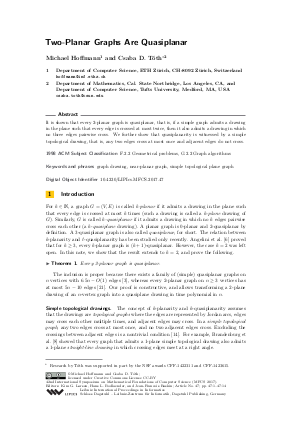Two-Planar Graphs Are Quasiplanar
Authors Michael Hoffmann, Csaba D. Tóth
-
Part of:
Volume:
42nd International Symposium on Mathematical Foundations of Computer Science (MFCS 2017)
Part of: Series: Leibniz International Proceedings in Informatics (LIPIcs)
Part of: Conference: Mathematical Foundations of Computer Science (MFCS) - License:
 Creative Commons Attribution 3.0 Unported license
Creative Commons Attribution 3.0 Unported license
- Publication Date: 2017-12-01
File

PDF
LIPIcs.MFCS.2017.47.pdf
- Filesize: 0.78 MB
- 14 pages
Document Identifiers
Subject Classification
Keywords
- graph drawing
- near-planar graph
- simple topological plane graph
Metrics
- Access Statistics
-
Total Accesses (updated on a weekly basis)
0PDF Downloads0Metadata Views
Abstract
It is shown that every 2-planar graph is quasiplanar, that is, if a simple graph admits a drawing in the plane such that every edge is crossed at most twice, then it also admits a drawing in which no three edges pairwise cross. We further show that quasiplanarity is witnessed by a simple topological drawing, that is, any two edges cross at most once and adjacent edges do not cross.
Cite As Get BibTex
Michael Hoffmann and Csaba D. Tóth. Two-Planar Graphs Are Quasiplanar. In 42nd International Symposium on Mathematical Foundations of Computer Science (MFCS 2017). Leibniz International Proceedings in Informatics (LIPIcs), Volume 83, pp. 47:1-47:14, Schloss Dagstuhl – Leibniz-Zentrum für Informatik (2017)
https://doi.org/10.4230/LIPIcs.MFCS.2017.47
BibTex
@InProceedings{hoffmann_et_al:LIPIcs.MFCS.2017.47,
author = {Hoffmann, Michael and T\'{o}th, Csaba D.},
title = {{Two-Planar Graphs Are Quasiplanar}},
booktitle = {42nd International Symposium on Mathematical Foundations of Computer Science (MFCS 2017)},
pages = {47:1--47:14},
series = {Leibniz International Proceedings in Informatics (LIPIcs)},
ISBN = {978-3-95977-046-0},
ISSN = {1868-8969},
year = {2017},
volume = {83},
editor = {Larsen, Kim G. and Bodlaender, Hans L. and Raskin, Jean-Francois},
publisher = {Schloss Dagstuhl -- Leibniz-Zentrum f{\"u}r Informatik},
address = {Dagstuhl, Germany},
URL = {https://drops.dagstuhl.de/entities/document/10.4230/LIPIcs.MFCS.2017.47},
URN = {urn:nbn:de:0030-drops-80811},
doi = {10.4230/LIPIcs.MFCS.2017.47},
annote = {Keywords: graph drawing, near-planar graph, simple topological plane graph}
}
Author Details
References
- Eyal Ackerman. On the maximum number of edges in topological graphs with no four pairwise crossing edges. Discrete Comput. Geom., 41(3):365-375, 2009. URL: http://dx.doi.org/10.1007/s00454-009-9143-9.
- Eyal Ackerman. On topological graphs with at most four crossings per edge. CoRR, abs/1509.01932:1-41, 2015. URL: https://arxiv.org/abs/1509.01932.
- Eyal Ackerman and Gábor Tardos. On the maximum number of edges in quasi-planar graphs. J. Combin. Theory Ser. A, 114(3):563-571, 2007. URL: http://dx.doi.org/10.1016/j.jcta.2006.08.002.
- Pankaj K. Agarwal, Boris Aronov, János Pach, Richard Pollack, and Micha Sharir. Quasi-planar graphs have a linear number of edges. Combinatorica, 17:1-9, 1997. URL: http://dx.doi.org/10.1007/BF01196127.
- Miklós Ajtai, Václav Chvátal, Monroe Newborn, and Endre Szemerédi. Crossing-free subgraphs. Ann. Discrete Math., 12:9-12, 1982. URL: http://dx.doi.org/10.1016/S0304-0208(08)73484-4.
- Patrizio Angelini, Michael A. Bekos, Franz J. Brandenburg, Giordano Da Lozzo, Giuseppe Di Battista, Walter Didimo, Giuseppe Liotta, Fabrizio Montecchiani, and Ignaz Rutter. On the relationship between k-planar and k-quasi planar graphs. In Proc. 43rd Internat. Workshop Graph-Theoret. Concepts Comput. Sci., Lecture Notes Comput. Sci. Springer, 2017. to appear; preliminary version available at arXiv:1702.08716. URL: http://arxiv.org/abs/1702.08716.
- Michael Bekos, Michael Kaufmann, and Chrysanthi Raftopoulou. On optimal 2- and 3-planar graphs. In Proc. 33rd Internat. Sympos. Comput. Geom., LIPIcs. SchloßDagstuhl, 2017. to appear; preliminary version available at arXiv:1703.06526. URL: http://arxiv.org/abs/1702.08716.
- Franz J. Brandenburg, Walter Didimo, William S. Evans, Philipp Kindermann, Giuseppe Liotta, and Fabrizio Montecchiani. Recognizing and drawing IC-planar graphs. Theoret. Comput. Sci., 636:1-16, 2016. URL: http://dx.doi.org/10.1016/j.tcs.2016.04.026.
- Christian A. Duncan. On graph thickness, geometric thickness, and separator theorems. Comput. Geom. Theory Appl., 44(2):95-99, 2011. URL: http://dx.doi.org/10.1016/j.comgeo.2010.09.005.
- David Eppstein, Philipp Kindermann, Stephen G. Kobourov, Giuseppe Liotta, Anna Lubiw, Aude Maignan, Debajyoti Mondal, Hamideh Vosoughpour, Sue Whitesides, and Stephen K. Wismath. On the planar split thickness of graphs. In Proc. 12th Latin Amer. Sympos. Theoretical Informatics, volume 9644 of Lecture Notes Comput. Sci., pages 403-415. Springer, 2016. URL: http://dx.doi.org/10.1007/978-3-662-49529-2_30.
- Jacob Fox and János Pach. Applications of a new separator theorem for string graphs. Combinatorics, Probability and Computing, 23(1):66-74, 2012. URL: http://dx.doi.org/10.1017/S0963548313000412.
- Jacob Fox and János Pach. Coloring K_k-free intersection graphs of geometric objects in the plane. European J. Combin., 33(5):853-866, 2012. URL: http://dx.doi.org/10.1016/j.ejc.2011.09.021.
- Jacob Fox, János Pach, and Andrew Suk. The number of edges in k-quasi-planar graphs. SIAM J. Discrete Math., 27(1):550-561, 2013. URL: http://dx.doi.org/10.1137/110858586.
- Radoslav Fulek, Michael J. Pelsmajer, Marcus Schaefer, and Daniel Štefankovič. Adjacent crossings do matter. J. Graph Algorithms Appl., 16(3):759-782, 2012. URL: http://dx.doi.org/10.7155/jgaa.00266.
- Michael Hoffmann and Csaba D. Tóth. Two-planar graphs are quasiplanar. CoRR, abs/1705.05569:1-22, 2017. URL: https://arxiv.org/abs/1705.05569.
- Stephen G. Kobourov, Giuseppe Liotta, and Fabrizio Montecchiani. An annotated bibliography on 1-planarity. CoRR, abs/1703.02261:1-38, 2017. URL: https://arxiv.org/abs/1703.02261.
- László Lovász. Graph minor theory. Bulletin of the American Mathematical Society, 43(1):75-86, 2006. URL: http://dx.doi.org/10.1090/S0273-0979-05-01088-8.
- János Pach, Radoš Radoičić, Gábor Tardos, and Géza Tóth. Improving the crossing lemma by finding more crossings in sparse graphs. Discrete Comput. Geom., 36(4):527-552, 2006. URL: http://dx.doi.org/10.1007/s00454-006-1264-9.
- János Pach, Radoš Radoičić, and Géza Tóth. Relaxing planarity for topological graphs. In More Graphs, Sets and Numbers, volume 15 of Bolyai Soc. Math. Studies, pages 285-300. Springer, 2006. URL: http://dx.doi.org/10.1007/978-3-540-32439-3_12.
- János Pach, Farhad Shahrokhi, and Mario Szegedy. Applications of the crossing number. Algorithmica, 16(1):111-117, 1996. URL: http://dx.doi.org/10.1007/BF02086610.
- János Pach and Géza Tóth. Graphs drawn with few crossings per edge. Combinatorica, 17(3):427-439, 1997. URL: http://dx.doi.org/10.1007/BF01215922.
- Marcus Schaefer. The graph crossing number and its variants: a survey. Electronic J. Combinatorics, #DS21:1-100, 2014. URL: http://www.combinatorics.org/ojs/index.php/eljc/article/view/DS21.
- Andrew Suk and Bartosz Walczak. New bounds on the maximum number of edges in k-quasi-planar graphs. Comput. Geom. Theory Appl., 50:24-33, 2015. URL: http://dx.doi.org/10.1016/j.comgeo.2015.06.001.
